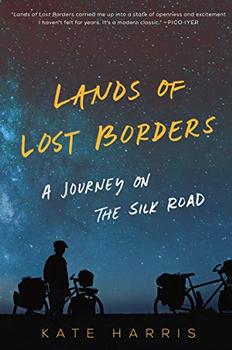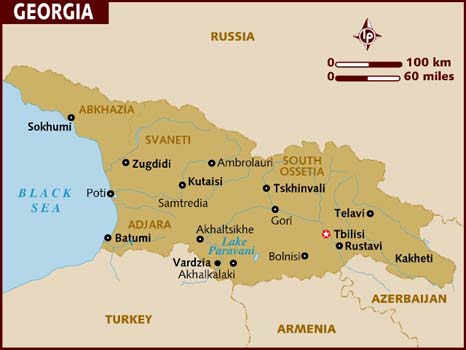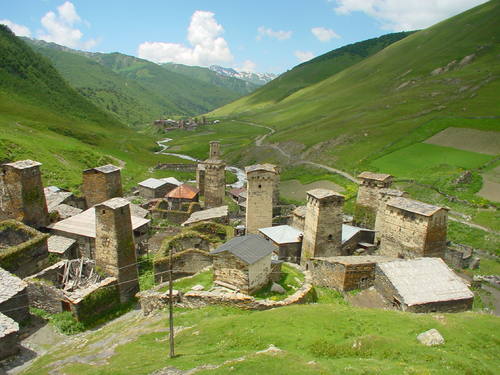Summary | Excerpt | Reviews | Beyond the Book | Read-Alikes | Genres & Themes | Author Bio

A Journey on the Silk Road
by Kate HarrisThis article relates to Lands of Lost Borders
 In Lands of Lost Borders, author Kate Harris and her friend Melissa Yule bicycle through eastern and central Asia, stopping in the Eurasian nation of Georgia. Bordered by Turkey, Armenia, Azerbaijan and Russia, Georgia was a member of the Soviet Union until the latter's dissolution in 1991, at which time it regained its independence. The country has a population of 5 million and covers approximately 69,700 sq km (slightly larger than West Virginia). 20% of Georgia's territory—South Ossetia and Abkhazia—is still disputed and occupied by Russian military forces.
In Lands of Lost Borders, author Kate Harris and her friend Melissa Yule bicycle through eastern and central Asia, stopping in the Eurasian nation of Georgia. Bordered by Turkey, Armenia, Azerbaijan and Russia, Georgia was a member of the Soviet Union until the latter's dissolution in 1991, at which time it regained its independence. The country has a population of 5 million and covers approximately 69,700 sq km (slightly larger than West Virginia). 20% of Georgia's territory—South Ossetia and Abkhazia—is still disputed and occupied by Russian military forces.
This is wild and rugged territory featuring natural biodiversity and a fascinating history. With major ports on the Black Sea, Georgia has been a hub of trade and commerce for centuries. Famous as the birthplace of both Queen Tamar and Joseph Stalin, the country has a complex political history as well.
Legendary Queen Tamar (1160-1213), daughter of Georgia's King George III, ruled for 28 years and fortified the region as a Christian empire, resisting invasion by neighboring Turks and Mongols. She is also known as Saint Tamara and is credited with ushering in a "golden age" of art and architecture. Joseph Stalin (1878-1953) was born into poverty and became a labor organizer and Bolshevik revolutionary. Shortly after the 1917 Russian Revolution, Stalin became the General Secretary of the Communist Party, and after the death of Vladimir Lenin in 1924, he ruled Russia with an iron fist for 30 years until his own death.
When Georgia became part of the Soviet Union (1921-1991), all commerce was centrally controlled by the state. Since 1991, the country has transitioned to a free market economy where enterprise at all levels is encouraged, including in the emerging tourism sector. Cyclists find exciting challenges with the extreme terrain; hikers, mountaineers, and spelunkers are attracted by the Caucasus Mountains. The mountains' many caves contain fossilized dinosaur footprints, underground rivers, and hidden dwellings.
More than one million Georgians live in the bustling capital city Tbilisi. Tbilisi offers historic museums, a contemporary arts scene, as well as wine bars, cafés, and shops featuring traditional hand-woven carpets. Landmarks reflect a diverse history: Christian cathedrals, an Islamic mosque, and a fortress constructed by Persians in the 8th century.
 Not far from Tbilisi, at the confluence of the Kura and Aragvi Rivers, is the town of Mtskheta, which was capital from the 3rd – 6th centuries CE. Today, Mtskheta is home to ancient monasteries and architecture reflecting its prominence and evolution across centuries. UNESCO has designated Mtskheta a World Heritage site and oversees the town's restoration and preservation efforts. Tucked away in the Caucasus Mountains lies another UNESCO site, the town of Svaneti. This area is home to over 200 remarkable stone tower dwellings constructed in the 9th-12th centuries CE.
Not far from Tbilisi, at the confluence of the Kura and Aragvi Rivers, is the town of Mtskheta, which was capital from the 3rd – 6th centuries CE. Today, Mtskheta is home to ancient monasteries and architecture reflecting its prominence and evolution across centuries. UNESCO has designated Mtskheta a World Heritage site and oversees the town's restoration and preservation efforts. Tucked away in the Caucasus Mountains lies another UNESCO site, the town of Svaneti. This area is home to over 200 remarkable stone tower dwellings constructed in the 9th-12th centuries CE.
 Evidence of human habitation in Georgia extends back 1.8 million years, evidenced by skulls and bones excavated near the town of Dmanisi. These represent the earliest hominid explorers; scientists have traced the migration and evolution of this Homo erectus population from Africa. Other fossils discovered at Dmanisi include primitive stone tools and animal remains—including those of a saber-toothed cat and giant ostrich—dated to the early Pleistocene era.
Evidence of human habitation in Georgia extends back 1.8 million years, evidenced by skulls and bones excavated near the town of Dmanisi. These represent the earliest hominid explorers; scientists have traced the migration and evolution of this Homo erectus population from Africa. Other fossils discovered at Dmanisi include primitive stone tools and animal remains—including those of a saber-toothed cat and giant ostrich—dated to the early Pleistocene era.
Georgia is the oldest known winemaking region on the planet. Archaeologists have dated clay kvevri vessels (used for storage during wine-fermentation) found there to around 6,000 BCE. The wine tradition endures; today hundreds of varietals are grown, bottled and exported using a mix of modern and ancient methods. Along with wine, author Kate Harris notes that the Georgian cuisine "combines carbohydrates, dairy, and nuts in the most creative, delicious, calorie-dense permutations imaginable."
Georgia held strategic importance during pre-industrial centuries of Silk Road trade. Modern explorers discover much to spark the imagination, traveling through Georgia in the footsteps of ancient humanity.
Svaneti tower structures, courtesy of UNESCO
Dmanisi skulls, courtesy of Dmanisi.ge
Map of Georgia, courtesy of Lonely Planet
Filed under Places, Cultures & Identities
![]() This "beyond the book article" relates to Lands of Lost Borders. It originally ran in August 2018 and has been updated for the
June 2019 paperback edition.
Go to magazine.
This "beyond the book article" relates to Lands of Lost Borders. It originally ran in August 2018 and has been updated for the
June 2019 paperback edition.
Go to magazine.
Your guide toexceptional books
BookBrowse seeks out and recommends the best in contemporary fiction and nonfiction—books that not only engage and entertain but also deepen our understanding of ourselves and the world around us.